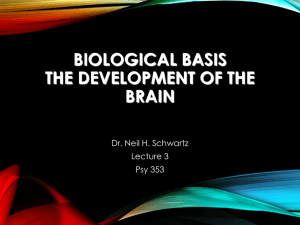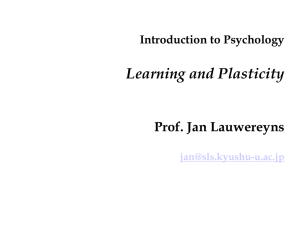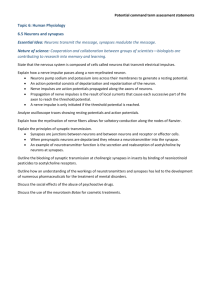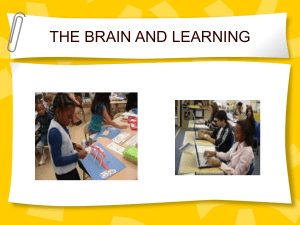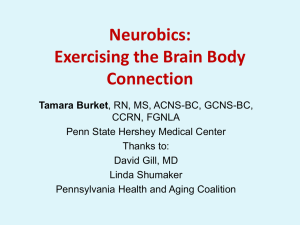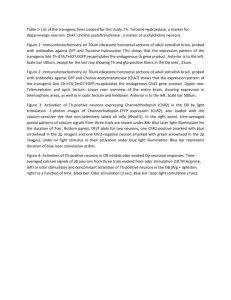3 - CSU, Chico
advertisement
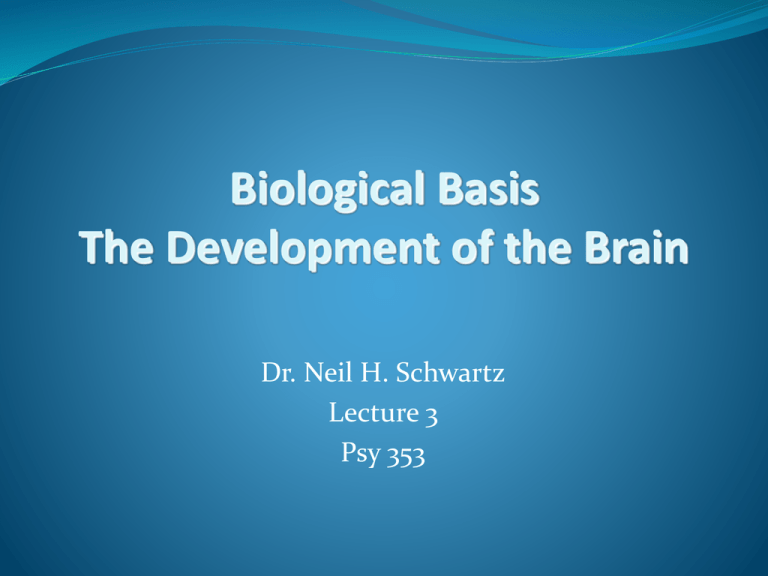
Biological Basis The Development of the Brain Dr. Neil H. Schwartz Lecture 3 Psy 353 Top Heavy At birth, the human brain weighs 25% of its eventual adult weight. The brain accounts for 10% of the overall body weight of a newborn. However, the infant brain is largely underdeveloped, only able to perform basic physiological functions. As newborns cannot yet control coordinated movement nor perform the complex mental operations characteristic of our species. Neuronal Development The nervous system is a communication system that uses electrical-chemical signals that are transmitted from one neuron, or specialized nerve cell, to another. There are 10 billion to more than 100 billion neurons in the mature human brain. Each neuron is connected to hundreds to thousands of other neurons via synapses. Proliferation, Migration, and Differentiation Neurons go through three stages of development. Proliferation – Occurs during the prenatal period and is characterized by cell division and mitosis. Migration – Once the cells are produced, the cells move to their permanent location in the brain, where thy collect with other cells to form the major parts of the brain. Differentiation – Once cells reach their final location, neurons begin to grow in size, producing more and longer dendrites, and extending their axons farther from the cell body. Synaptogenesis and Apoptosis Synaptogenesis – Is the process of synapse formation. It occurs rapidly during the early years of life and continues throughout life, as the brain changes in response to new information. However, the brain has many more synapses and neurons than it needs, and the process of synaptic pruning occurs, apoptosis or selective cell death. Myelination Myelin – a fatty substance that surrounds the axons of neurons and promotes faster transmission of electrical signals. Advantages Fire more rapidly Lower sensitivity threshold Greater functional specificity – “less leakage” The Role of Experience in Brain Development Specific experiences produce neural activity that determine which of the excess synapses will survive. Experience-expectant processes – functions will develop for all members of a species, given a speciestypical environment. Those neurons and connections that receive the species- expected experience live and become organized with other activated neurons, and those that do not receive such activation die. Experience (or lack thereof) changes structure and organization in the brain. Example: visual nervous system development The Role of Experience in Brain Development Experience-dependent processes – connections are made due to the unique experiences that an individual has. Overall, the overproduction of neurons enables an individual to make connections and store information that reflects one’s particular environment. Therefore, when certain experiences are not experienced, and these certain neurons are not activated, then the neurons die. Plasticity Plasticity refers to the ability to change. Although the brain cannot produce any new neurons, new synaptic connections can occur throughout life. Due to experience Through enriched environmental stimulation Research suggests that enriched animals have heavier and thicker neocortexes, larger neurons with more dendrites, and more synaptic connections. Plasticity Brain damage Kennard Principle – if one must have brain damage, do it early, for a young brain is more likely to recover normal function than an older brain. However, when the damage is to an area of the brain that is involved with more general cognitive functioning rather than with a specific cognitive ability such as language, the reverse is often true. Drugs



